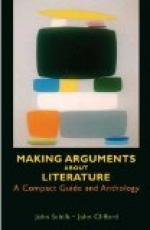Then there are the innumerable local and state questions that touch the fathers of at least half of any class, and that the sons may be in the way of hearing discussed at home, or may be sent to hear discussed in legislatures and city councils. Every instructor who takes a daily newspaper will be provided with more of these subjects than his class can use. For their facts the students can go to the newspapers, to printed reports, to the persons who are concerned with the questions which they are going to argue. In some cases the students will get valuable interest and advice from the older men who have the active charge of the questions under discussion; and it is not inconceivable, that if some of the latter happen to be graduates of the college or school, they will even read the arguments and make helpful criticisms on them. The grateful interest of graduates is a source which has not been overdrawn for aid in the processes of instruction.
Many of the subjects which I have here offered as suggestions can be discussed in part, at any rate, within the space of an editorial article; and that I conceive to be about the length which most arguments written by students, except those in special courses, will run to. In so short a space, it is hardly necessary to point out, evidence cannot be presented and discussed with the detail, say, of Webster’s “Speech in the White Murder Case.” It would be a good separate exercise to call for such detailed presentation of evidence on some single point in the argument. With most classes, however, the instructor cannot do much more than rule out wholly unsupported assertion, and insist that the distinction between fact and inference from fact shall be kept in sight.
The second of the results which an instructor in a course in argumentation should aim for is the power to analyze complicated masses of facts and so arrange them and present them as to bring order out of confusion. President Taft has said that Justice Hughes “won his reputation at the bar by his gift of boring to the innermost core of a subject”; and that is what the drill on the introduction to the brief should to some degree impart to students. The orderly analysis of the question, step by step, according to the admirable scheme devised by Professor Baker, cannot help implanting some understanding of what it means to go to the heart of a question. Every man sooner or later, must face complicated and puzzling questions; and the ordinary man will give himself a long start if he will thus put down on paper the points that can be urged on the two sides of a question, and then study them until the real points at issue emerge. Then the drill in laying out the logical skeleton of an argument, so plainly that no false or broken connection can escape detection, will strengthen the conscience for clearness and coherence of thought; and the necessity for getting back to ultimate facts for every assertion, and putting down the source from which the facts are derived, will help to implant a wholesome respect for facts as something different from assertion.




